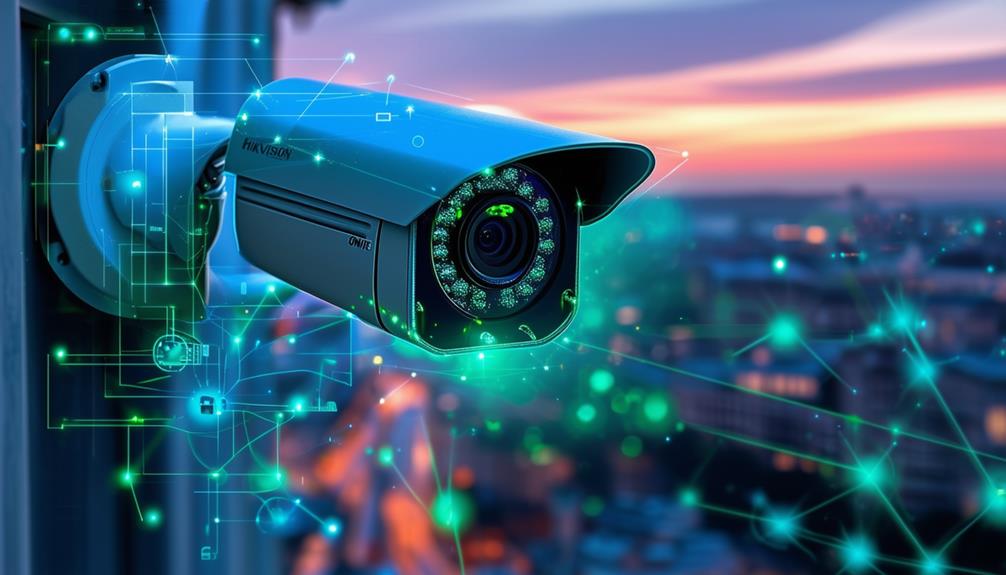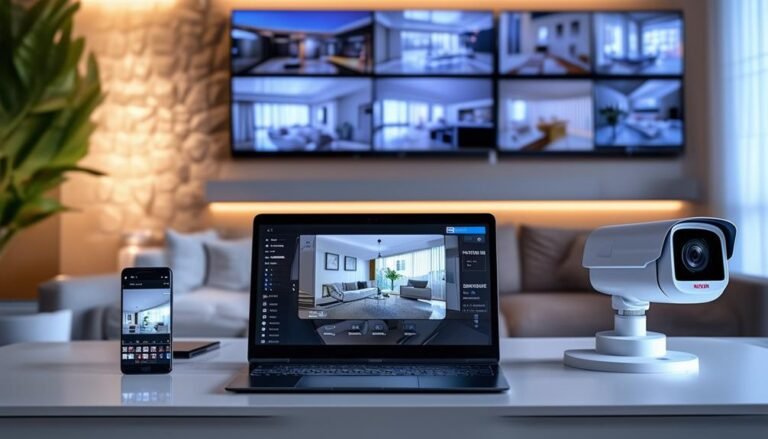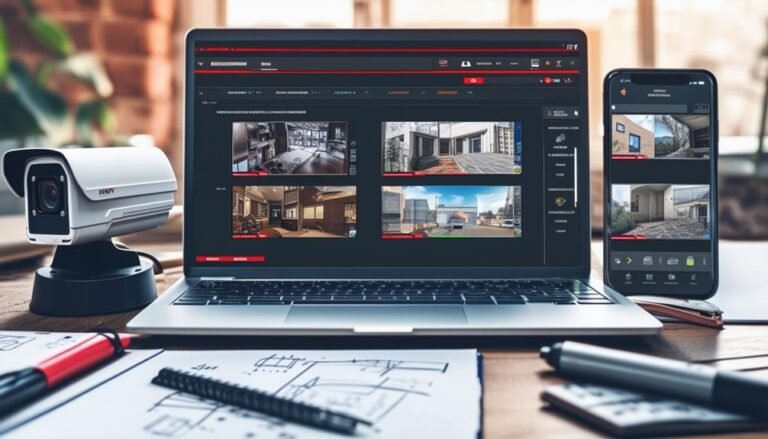Yes, Hikvision fully supports ONVIF, which means you can easily integrate its devices with others in your security system. By adhering to ONVIF standards, Hikvision guarantees compatibility across various brands, allowing you to mix and match devices without hassle. This support provides flexibility and future-proofing for your security solutions. Regular updates from Hikvision help maintain and enhance this compatibility, further assuring smooth operation. If you want to know more about how this integration works and the benefits involved, there's plenty more to explore about Hikvision and ONVIF compatibility.
Overview of ONVIF
ONVIF's mission is to standardize communication between IP-based physical security products, making it easier for users to integrate various devices from different manufacturers. This standardization empowers you with the freedom to choose devices that best suit your needs without being tied down to a single brand. Imagine having the flexibility to mix and match cameras, access control systems, and video management software from different vendors while ensuring they work seamlessly together.
By adhering to ONVIF specifications, manufacturers can create products that communicate efficiently, which enhances your ability to build a customized security solution. This interoperability not only simplifies installation but also reduces long-term costs, sparing you from the headaches that come with proprietary systems. You won't have to worry about compatibility issues or being locked into a specific vendor's ecosystem.
ONVIF also promotes innovation in the security industry. As manufacturers comply with ONVIF standards, they can focus on developing advanced features and technologies, knowing they'll be compatible with a wide range of devices. This means you benefit from the latest advancements without feeling constrained by outdated technology.
In essence, ONVIF is about empowering you with choices and freedom in your security solutions. Whether you're a business owner looking to secure your premises or a homeowner wanting peace of mind, ONVIF gives you the flexibility to tailor your system to your specific needs. Embrace the freedom that comes with ONVIF compliance and create a security network that works for you.
Hikvision's Product Range
Hikvision offers a diverse range of products designed to meet various security needs, from high-definition cameras to advanced video management systems. When you're looking to enhance your security setup, Hikvision's offerings can give you the flexibility and control you desire. Here's a snapshot of what you can expect:
- High-Definition Cameras: Capture crystal-clear images with options ranging from basic models to sophisticated multi-sensor cameras.
- PTZ Cameras: Experience freedom of movement with pan-tilt-zoom capabilities, allowing you to monitor large areas effectively.
- Video Management Software: Take charge of your surveillance with user-friendly software that enables easy access, playback, and management of your video feeds.
- Access Control Solutions: Secure physical spaces with advanced access control systems that integrate seamlessly with your existing setup.
With Hikvision, you have the tools to tailor your security solution to your unique needs. Whether you're protecting a small business, a large facility, or your home, their product range empowers you to make informed decisions. You won't have to sacrifice quality for flexibility; instead, you can create a thorough security solution that fits your lifestyle. The choice is yours, and with Hikvision, you can confidently take charge of your security needs. Embrace the freedom to monitor, manage, and protect what matters most to you!
ONVIF Compliance Explained
Understanding ONVIF compliance is essential for anyone looking to integrate various security devices into a cohesive system. ONVIF, or Open Network Video Interface Forum, is an open standard for IP-based security products. It allows devices from different manufacturers to communicate seamlessly, giving you the freedom to choose products that best fit your needs without being locked into a specific brand.
When a device is ONVIF compliant, it means it adheres to a set of standardized protocols that facilitate interoperability. This compliance guarantees that your cameras, recorders, and other components can work together, regardless of their origin. You'll find that many manufacturers, including Hikvision, aim for ONVIF compliance to appeal to customers who value flexibility and choice.
In practical terms, ONVIF compliance covers various functionalities, including video streaming, device discovery, and configuration. If you're setting up a security system, this means you won't have to worry about compatibility issues down the line. You can mix and match devices, enhancing your system's capabilities without the headache of proprietary restrictions.
Ultimately, ONVIF compliance empowers you to design a security solution tailored to your unique requirements. It frees you from the constraints of brand loyalty and fosters a diverse ecosystem of devices that can adapt to your evolving security needs. So, when you're selecting your next security device, keep ONVIF compliance in mind to facilitate a smooth integration process.
Benefits of ONVIF Support
When you choose devices that support ONVIF, you're unfastening enhanced compatibility with a wide range of products. This makes system integration much simpler, allowing you to mix and match components without hassle. Plus, with ONVIF's ongoing development, you're investing in future-proof technology solutions that can adapt to your evolving needs.
Enhanced Device Compatibility
Enhanced device compatibility is a significant advantage of ONVIF support, allowing you to seamlessly integrate a variety of security devices from different manufacturers. This freedom means you can choose the best equipment that fits your unique needs without being locked into a single brand. With ONVIF, you can mix and match devices, ensuring your security system is tailored just for you.
Here are some benefits of this enhanced compatibility:
- Flexibility in Choices: You're not limited to one vendor, so you can select devices that meet your specific requirements.
- Cost-Effectiveness: You can often find more affordable options from various manufacturers without sacrificing quality.
- Future-Proofing: As technology evolves, you can easily add new devices to your system, keeping it up-to-date.
- Interoperability: Different devices can work together seamlessly, making management and monitoring a breeze.
In short, ONVIF support empowers you to create a customized security system that reflects your preferences. It gives you the freedom to innovate and adapt, ensuring your security solutions can grow alongside your needs.
Simplified System Integration
One of the key benefits of ONVIF support is that it simplifies system integration across different security devices. If you're managing a security system, you know how frustrating it can be to juggle multiple brands and technologies. With ONVIF, you've got a standardized protocol that allows devices from various manufacturers to communicate seamlessly. This means you can mix and match cameras, recorders, and other equipment without worrying about compatibility issues.
You get the freedom to customize your security setup according to your specific needs. Want to add a new camera? No problem! Just verify it's ONVIF-compliant, and you can integrate it into your existing system without a hitch. This not only saves you time but also reduces the costs associated with proprietary solutions.
Furthermore, ONVIF support enhances your ability to scale your system as your needs grow. You're not locked into a single vendor's ecosystem; instead, you can choose the best products available in the market. With simplified integration, you can focus on what really matters—keeping your premises secure. So, embrace the flexibility ONVIF brings and take control of your security infrastructure!
Future-Proof Technology Solutions
With ONVIF support, you're not just investing in current technology; you're building a future-proof security system. This means you're setting yourself up for flexibility and adaptability as your needs evolve. Embracing ONVIF standards allows you to seamlessly integrate devices from various manufacturers, ensuring your system remains relevant and scalable.
Here are some key benefits of ONVIF support:
- Interoperability: Mix and match devices from different brands, giving you the freedom to choose the best products for your specific needs.
- Cost-Effectiveness: Avoid vendor lock-in, allowing you to find competitive pricing and better deals as technology advances.
- Easier Upgrades: As new technologies emerge, you can easily incorporate newer devices without overhauling your entire system.
- Enhanced Security: Benefit from continuous improvements in security protocols that come with ONVIF compliance, keeping your system robust against threats.
In a world where technology rapidly evolves, ONVIF support empowers you to maintain control over your security infrastructure. You can adapt and grow without the constraints of proprietary systems, ensuring your investment remains valuable for years to come.
Compatibility With Other Brands
Hikvision cameras frequently demonstrate strong compatibility with various brands in the security industry, thanks to their adherence to the ONVIF (Open Network Video Interface Forum) standards. This means you can often integrate Hikvision products with other manufacturers' systems without hassle, giving you more flexibility in your security setup. If you've invested in a range of devices, you'll appreciate how ONVIF compliance allows for seamless communication between them, no matter the brand.
When you're looking to expand or upgrade your security system, you want options. With Hikvision's compatibility, it's easier to mix and match your devices. Whether you're using different camera brands, recording systems, or software, you can maintain a cohesive and efficient security solution. You won't be tied down to a single manufacturer, which can be limiting and costly.
Moreover, this interoperability not only enhances your system's functionality but also supports your freedom to choose the best technology that meets your specific needs. You can tailor your security setup with confidence, knowing that Hikvision will likely work well with other ONVIF-compliant devices.
How to Check ONVIF Support
Before integrating any new devices into your security system, it's essential to verify their ONVIF support. This step guarantees that your devices will communicate seamlessly, allowing you the freedom to mix and match equipment without compatibility issues. Here's how you can check for ONVIF support:
- Consult the Manufacturer's Documentation: Look for information on the device specification sheets or user manuals. Many manufacturers clearly state whether their products support ONVIF.
- Visit the ONVIF Website: The official ONVIF website has a list of compliant devices. You can search by manufacturer or model to confirm if the equipment you're considering is ONVIF compliant.
- Use an ONVIF Device Manager: There are various software tools available that can scan your network for ONVIF-compatible devices, giving you a quick overview of what's supported.
- Test the Device: If you already have the device on hand, you can attempt to connect it to an ONVIF-compatible system. If it integrates smoothly, you're in the clear!
Common Issues and Solutions
Integrating ONVIF-compliant devices into your security setup can sometimes lead to unexpected challenges. You might find that devices don't connect as expected, or the features you need aren't functioning properly. But don't worry! Here are some common issues you might face and their solutions to help you regain control of your security system.
| Issue | Solution |
|---|---|
| Device not showing up | Check network settings; verify all devices are on the same subnet. |
| Incomplete features available | Verify that the latest firmware is installed on both the camera and the NVR. |
| Playback issues | Confirm that the NVR supports the codec used by your camera. If not, consider alternative recording settings. |
| Stream lagging or dropping | Investigate network bandwidth; reduce the video quality settings if necessary. |
You'll want to start by verifying that your devices are properly configured and set up. Double-check your network settings, as many issues stem from simple connectivity problems. If features aren't available, updating firmware can often resolve compatibility issues.
For playback problems, codec mismatches can be a real headache, so consider checking compatibility lists beforehand. Finally, if you're experiencing lag, it might be time to evaluate your network's capacity.
With these tips, you'll be well-equipped to tackle common ONVIF integration issues and keep your surveillance system running smoothly. Embrace the freedom of a finely tuned security setup!
User Experiences and Feedback
When it comes to ONVIF-compliant devices, user experiences can vary widely, providing valuable insights into their strengths and weaknesses. If you're considering Hikvision cameras, you might find a mixed bag of feedback. Some users appreciate the flexibility that ONVIF compliance offers, while others have encountered challenges that can be frustrating.
Here's a quick breakdown of common feedback points:
- Integration Ease: Many users report that Hikvision cameras integrate seamlessly with third-party software, allowing for a diverse range of applications and setups.
- Video Quality: A significant number of users commend the high-resolution video quality, which enhances surveillance capabilities and provides clarity for identification.
- Customer Support: Feedback on customer support can be hit or miss. Some users praise the responsiveness, while others feel left in the dark during troubleshooting.
- Firmware Updates: Users often express concerns about firmware updates, citing issues that arise post-update, which can disrupt functionality and require additional workarounds.
Ultimately, your experience will depend on your specific needs and how you plan to use Hikvision products. It is crucial to weigh these user insights while exploring your options. The freedom to customize your surveillance system can be a game-changer, but being aware of potential pitfalls will help you make a more informed decision. Always consider the collective experiences of others to shape your expectations and strategies when integrating these devices into your setup.
Future of Hikvision and ONVIF
As users weigh their experiences with Hikvision and ONVIF, it's important to reflect on what lies ahead for these technologies. With the increasing demand for smart surveillance solutions, both Hikvision and ONVIF are poised to evolve. You might wonder how these developments will shape your freedom in choosing and integrating security systems.
One key aspect to take into account is the collaboration between manufacturers and the ONVIF standard. As more companies adopt ONVIF, you'll likely see a broader range of compatible products that enhance interoperability. This means you can enjoy greater flexibility in selecting devices that suit your specific needs.
Here's a quick look at potential future trends:
| Trend | Implications |
|---|---|
| Increased Interoperability | Greater choice of devices without vendor lock-in |
| Enhanced Cybersecurity | Improved protection for your surveillance data |
| AI Integration | Smarter analytics and decision-making capabilities |
In this dynamic landscape, Hikvision might also focus on aligning its offerings with ONVIF standards to guarantee you have access to the latest innovations. As you explore your options, keep in mind that the future will likely involve a blend of advanced technology and user-centric designs, ensuring that your surveillance solutions not only meet regulatory requirements but also empower your freedom to choose.
Staying informed about these trends will help you make better decisions for your security needs, allowing you to leverage the best technologies available while maintaining control over your system.
Best Practices for Integration
Successful integration of Hikvision and ONVIF devices can greatly enhance your security system's performance. When you approach this integration, keeping a few best practices in mind can make a world of difference. You want your system to function seamlessly, guaranteeing you have the freedom to monitor and manage your security without hassle.
Here are some key practices for successful integration:
- Check Compatibility: Confirm that your Hikvision devices support ONVIF profiles. This will save you time and headaches down the line.
- Update Firmware: Regularly update the firmware on both your Hikvision and ONVIF devices. This not only improves compatibility but also guarantees enhanced security features.
- Use a Reliable Network: A strong, stable network is essential for effective communication between devices. Consider using dedicated bandwidth for your security system to minimize interruptions.
- Test Regularly: After integration, conduct regular tests to confirm everything's working as intended. This helps you catch any issues early and maintain peace of mind.
Frequently Asked Questions
How Do I Update Hikvision Firmware for ONVIF Compatibility?
To update your Hikvision firmware for Onvif compatibility, start by checking the current version on your device. Visit the Hikvision website and locate the latest firmware for your model. Download it, then log into your camera's web interface. Navigate to the firmware update section, upload the downloaded file, and follow the prompts. This'll enhance your device's interoperability, ensuring you can seamlessly connect with other Onvif-compliant systems. Don't forget to restart your device afterward!
Are There Specific Hikvision Models That Lack ONVIF Support?
Yes, there are specific Hikvision models that lack ONVIF support. Generally, older or entry-level models might not include this compatibility. If you're looking to integrate your devices seamlessly with other systems, it's best to check the specifications of each model before purchasing. You don't want to end up with a device that limits your freedom to choose other equipment. Always verify current compatibility to guarantee you're making the right choice for your needs.
Can I Use Hikvision Cameras With Non-Onvif Software?
You can certainly use Hikvision cameras with non-ONVIF software, but it's a bit like trying to fit a square peg in a round hole. Depending on the software, you might run into compatibility issues. Always check the software's compatibility list or reach out to the developers. Remember, the more options you explore, the more freedom you'll have in your security setup. So, don't hesitate to experiment!
What Is the Process for Troubleshooting ONVIF Connection Issues?
When troubleshooting ONVIF connection issues, start by checking the network settings on both the camera and your software. Confirm they're on the same subnet. Next, verify that the ONVIF protocol's enabled on the camera. You might also want to test the credentials you're using—incorrect ones can cause problems. If you're still having trouble, try restarting both devices, and consider checking for firmware updates that could resolve compatibility issues.
Is There a Cost Associated With Hikvision's ONVIF Support?
You'd think that getting support for Onvif with Hikvision would come with a hefty price tag, right? But surprisingly, it doesn't! Typically, Hikvision's support for Onvif is included with their products, meaning you won't be shelling out extra cash just to connect your devices. Of course, always check specific model details, but for most users, it's a refreshing change to find compatible tech without those hidden fees lurking around!



